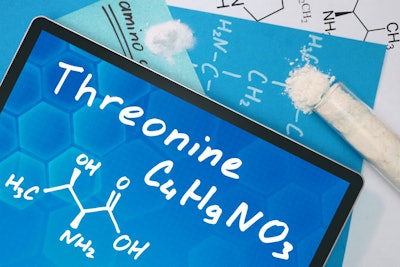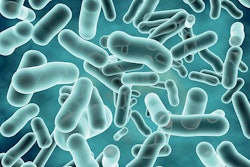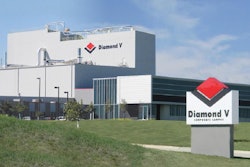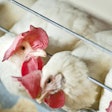
To address the current shortage of feed-grade L-threonine, we need to consider natural sources of this amino acid.
Threonine is one of the essential amino acids, meaning it cannot be synthesized internally and, as such, animals must consume it through their feed.
Threonine is also one of the most limiting amino acids, meaning that it exists in relative limited amounts relative to animal needs for this amino acid. In fact, in poultry it is third limiting after methionine (along with cysteine) and lysine, which are first and second limiting amino acids, respectively. In pigs, threonine is second limiting after lysine and it is followed by methionine. Birds need more methionine and cysteine (the sulfur-containing amino acids) because their feathers contain an excessive amount of these amino acids.
Corn, one of the major feed ingredients, is rather deficient in lysine and threonine and relatively rich in methionine, whereas soybean meal – another major feed ingredient – is more abundant in lysine and threonine and rather poor in methionine. This is why a corn plus soybean meal diet is considered one of the best combinations for monogastric animals like poultry and pigs.
Threonine also exists as a feed-grade amino acid ingredient, produced by bacterial fermentation at a 99% purity. So, in modern low-protein diets, soybean meal usage is curtailed by the relatively less expensive feed-grade amino acids, among which is L-threonine.
Implications regarding availability of this feed-grade amino acid in pure form, due to the issues arising from the new coronavirus pandemic, have caused a shortage of this amino acid in the global market. Using less of this amino acid is not advisable as it will lower growth performance, unless the total amino acid complement is lowered along with energy in the diet, forcing thus animals to consume more feed to compensate for a diluted nutrient density. But, even then, animals will continue to consume the same amount of threonine (or any other amino acid that becomes scarce in the near future). Thus, we need to reconsider alternative sources of proteins that contain more threonine than soybean meal.
How to consider alternatives
We can do this in two ways. First, we look at the total (and digestible eventually) content in each ingredient (Table 1).
There we see that soybean meal contains about 18 g/kg (or 1.8%) total threonine. Surpisingly, the richest threonine source is a plant protein, that of potato protein with more than 43 g/kg. It is followed, as it was to be expected, by concentrated forms of animal-derived ingredients, such as blood, feather, fish and poultry meals. A few other concentrated sources of vegetable proteins such as peas and alfalfa also contain relatively high amounts of threonine.
The second way we need to look at these numbers is the concentration of threonine within its protein in each ingredient. This is done because soybean meal contains a large amount of total protein (44%) whereas others may contain less. For example, whey that does not figure on Table 1 rates rather high in Table 2, but it contains only about 11% total protein. So, it cannot contribute as much total threonine in the final diet.
Of course, the digestibility values should also be taken into account, and here we come into the final evaluation step.
All of the above values, along with the price of each ingredient, and the contextual formulation design are taken into account by the feed formulation software that will provide a least cost solution. Perhaps, it will pull in some potato protein, or even more soybean meal, as it will consider the cost of “natural” threonine versus that of “synthetic” one, while performing the solution within the constraints of having all ingredients sum up to 100%, while also meeting all other nutrient specifications. At the end, if faced by a threonine shortage, talk to your nutritionist to find the best solution.
In closing, the values presented in the two tables here should be taken as a comparative guide. Your nutritionist will use those tables or analytical values most suitable to available ingredients in each situation. And, as always, it is highly recommended to formulate on digestible/available and not total amino acids, especially when non-traditional feed ingredients are used.
Table 1. Ingredients rich in threonine on a total percentage basis
| Feed ingredient | As fed (g/kg) |
| L-threonine (feed-grade pure amino acid) | 990 |
| Potato protein concentrate | 43.4 |
| Blood meal | 40.7 |
| Feather meal | 36.7 |
| Fish solubles, condensed | 31.7 |
| Poultry meal, protein > 70% | 31.1 |
| Fish meal, protein 70% | 28.9 |
| Poultry meal, protein < 70% | 25.4 |
| Alfalfa protein concentrate | 25.0 |
| Pea protein concentrate | 24.7 |
| Mealworm larvae, dried | 24.4 |
| Soybean protein concentrate, protein 60-70% | 23.6 |
| Wheat gluten | 21.6 |
| Corn gluten meal | 20.4 |
| Black soldier fly larvae, dried | 20.1 |
| Brewers yeast, dried | 19.1 |
| Soybean meal, protein 44% | 17.7 |
Source: Adapted from INRA-CIRAD-AFZ feed tables, www.feedtables.com
Table 2. Ingredients rich in threonine on a protein (g/16g nitrogen) basis
| Feed ingredient | g/16g N |
| L-threonine | 135 |
| Olive pulp, oil < 10% | 6.2 |
| Potato protein concentrate | 5.6 |
| Whey powder, sweet | 5.5 |
| Mealworm larvae, dried | 5.1 |
| Whey permeate | 4.9 |
| Alfalfa protein concentrate | 4.8 |
| Rapeseed, whole, extruded | 4.8 |
| Feather meal | 4.7 |
| Blood meal | 4.6 |
| Beet pulp, dried | 4.5 |
| Linseed, whole, extruded | 4.4 |
| Milk powder, skimmed | 4.4 |
| Brewers yeast, dried | 4.3 |
| Rapeseed meal, oil < 5% | 4.3 |
| Fish solubles, condensed | 4.3 |
| Poultry meal, protein > 70% | 4.1 |
| Fish meal, protein 65% | 4.1 |
| Fish meal, protein 70% | 4.1 |
| Soybean, whole, extruded | 4.0 |
| Poultry meal, protein < 70% | 4.0 |
| Black soldier fly larvae, dried | 3.9 |
| Linseed meal, oil > 5% | 3.9 |
| Lupin, blue | 3.9 |
| Millet, pearl | 3.9 |
| Soybean meal, protein 44% | 3.9 |
Source: Adapted from INRA-CIRAD-AFZ feed tables, www.feedtables.com















